Charles E W Bean, Diaries, AWM38 3DRL 606/259/1 - 1917 - 1927 - Part 16


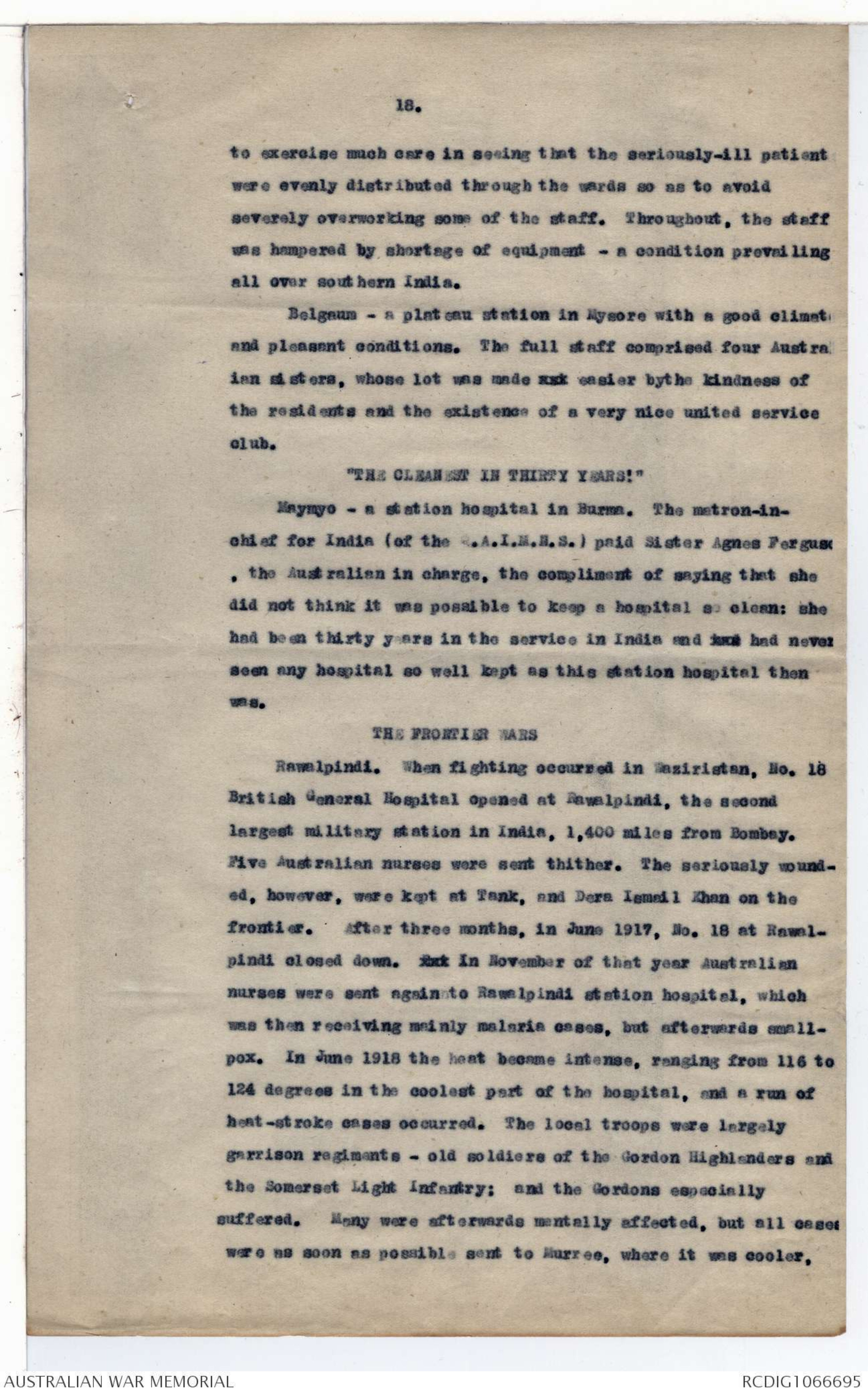
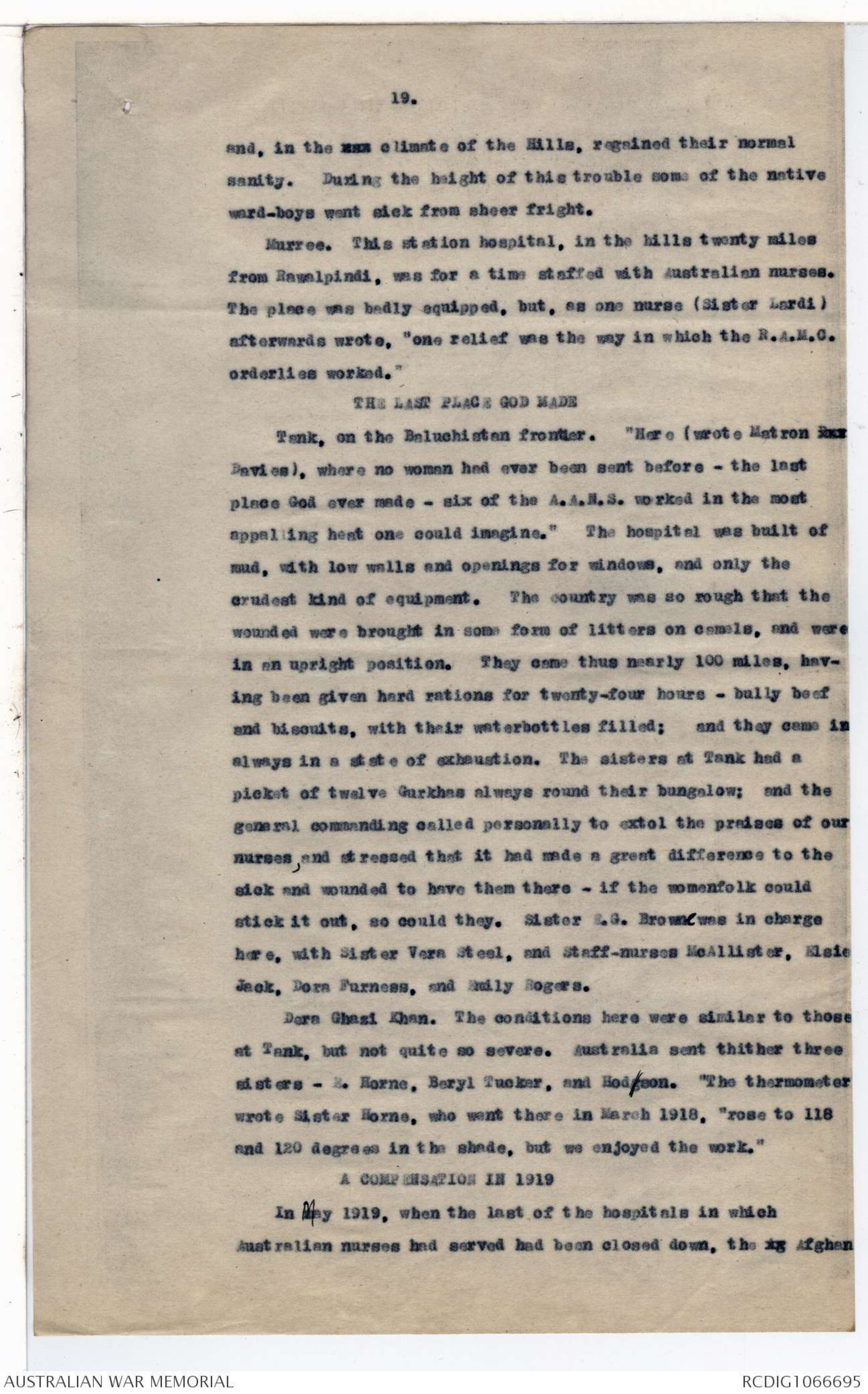

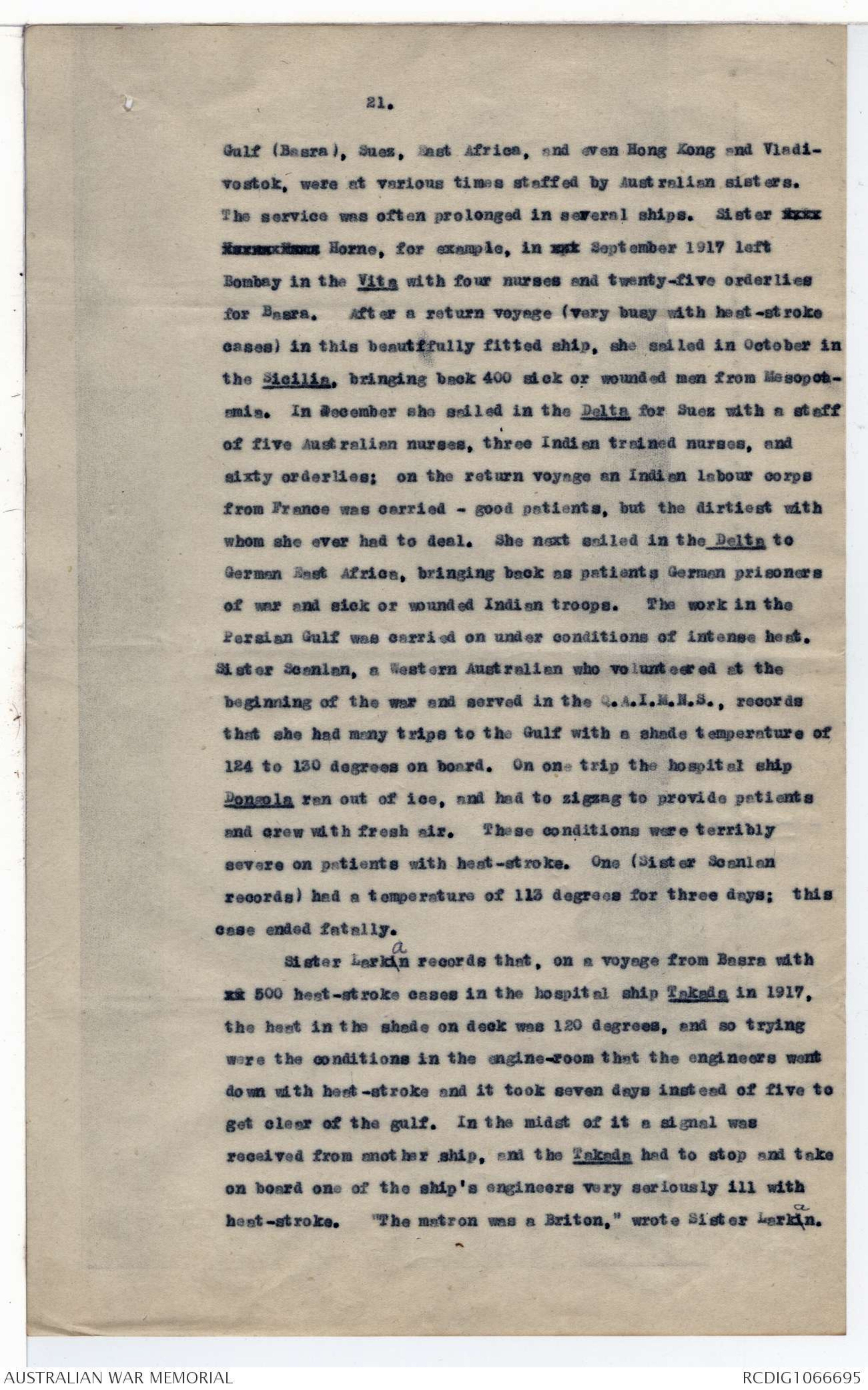

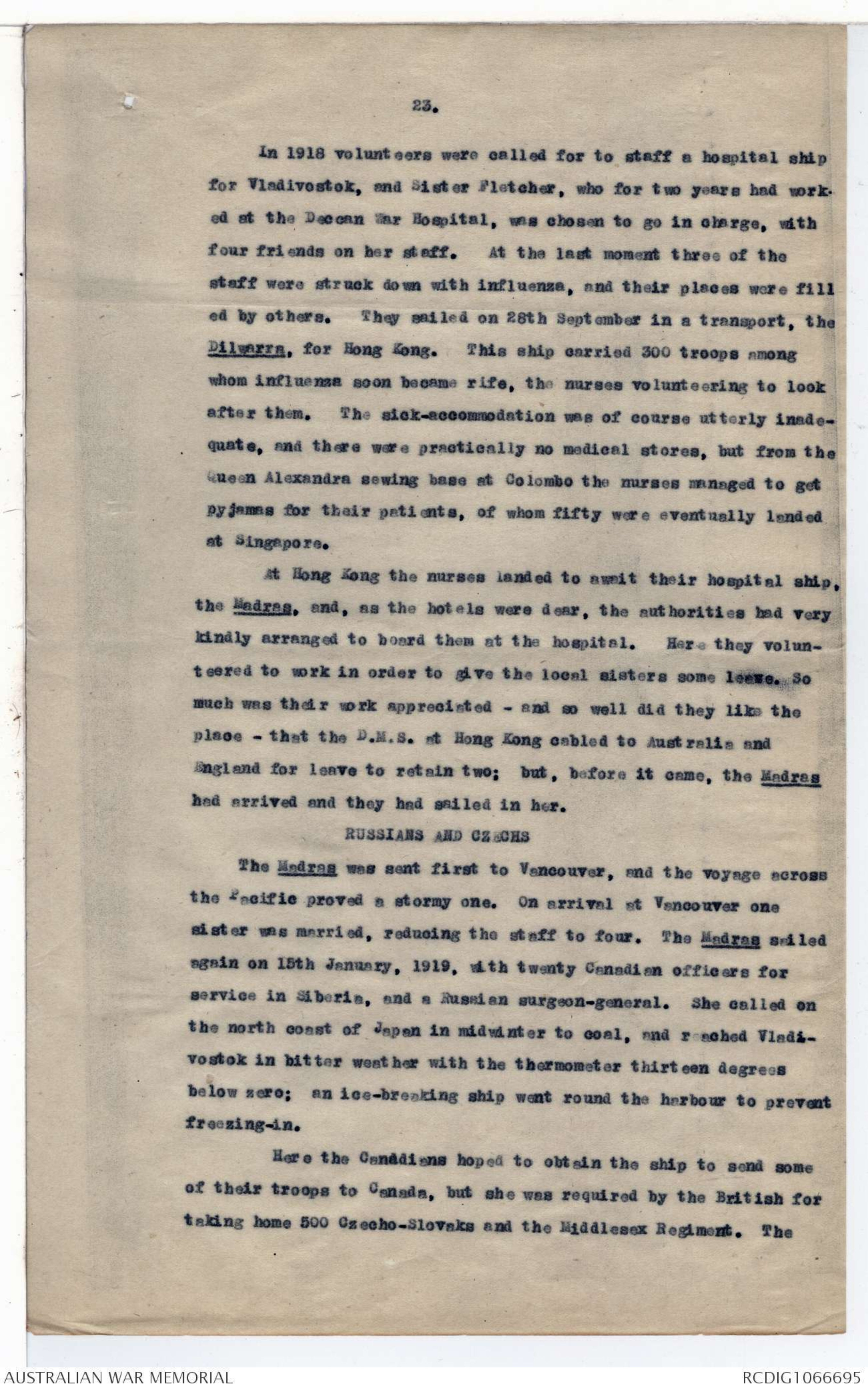
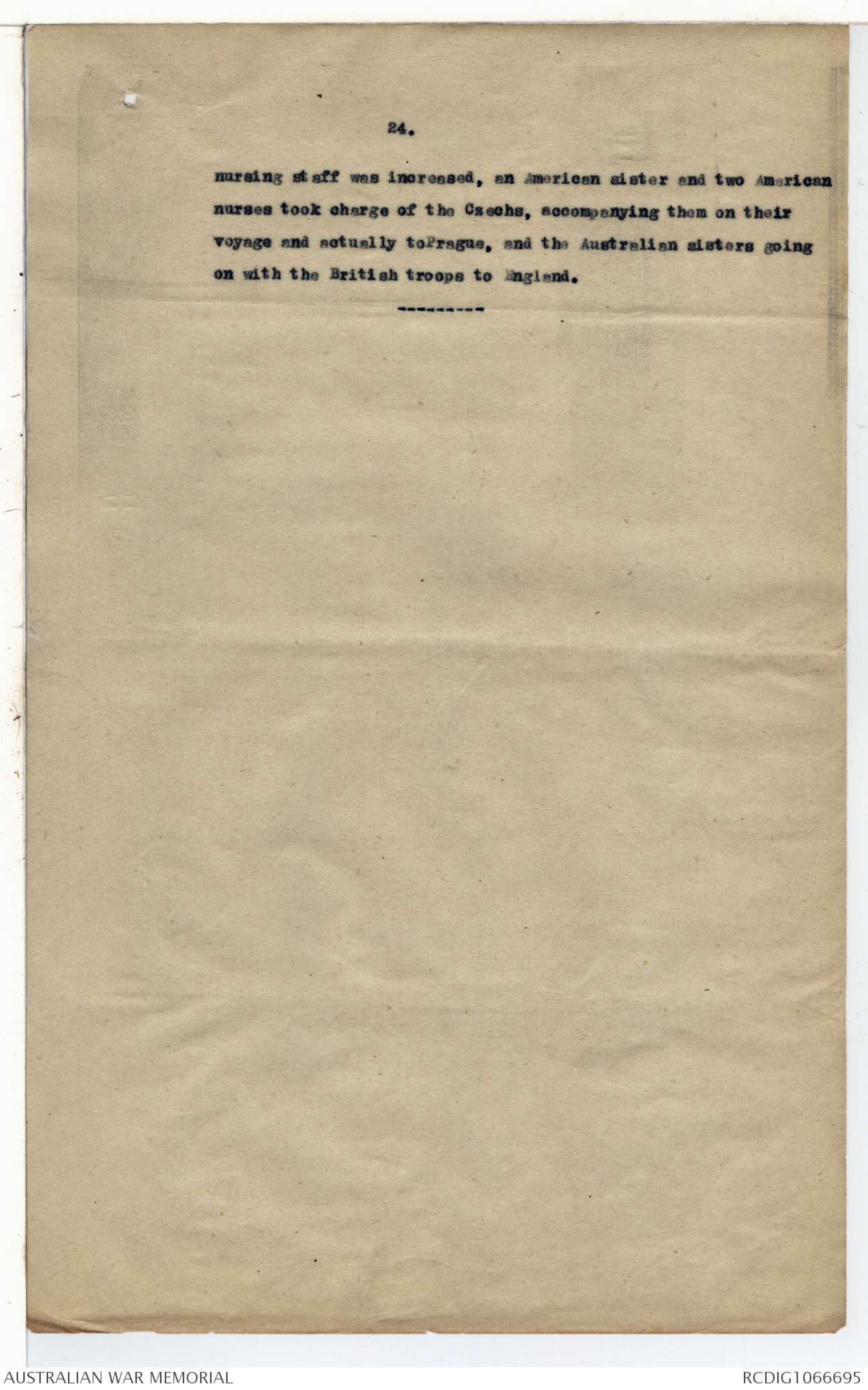
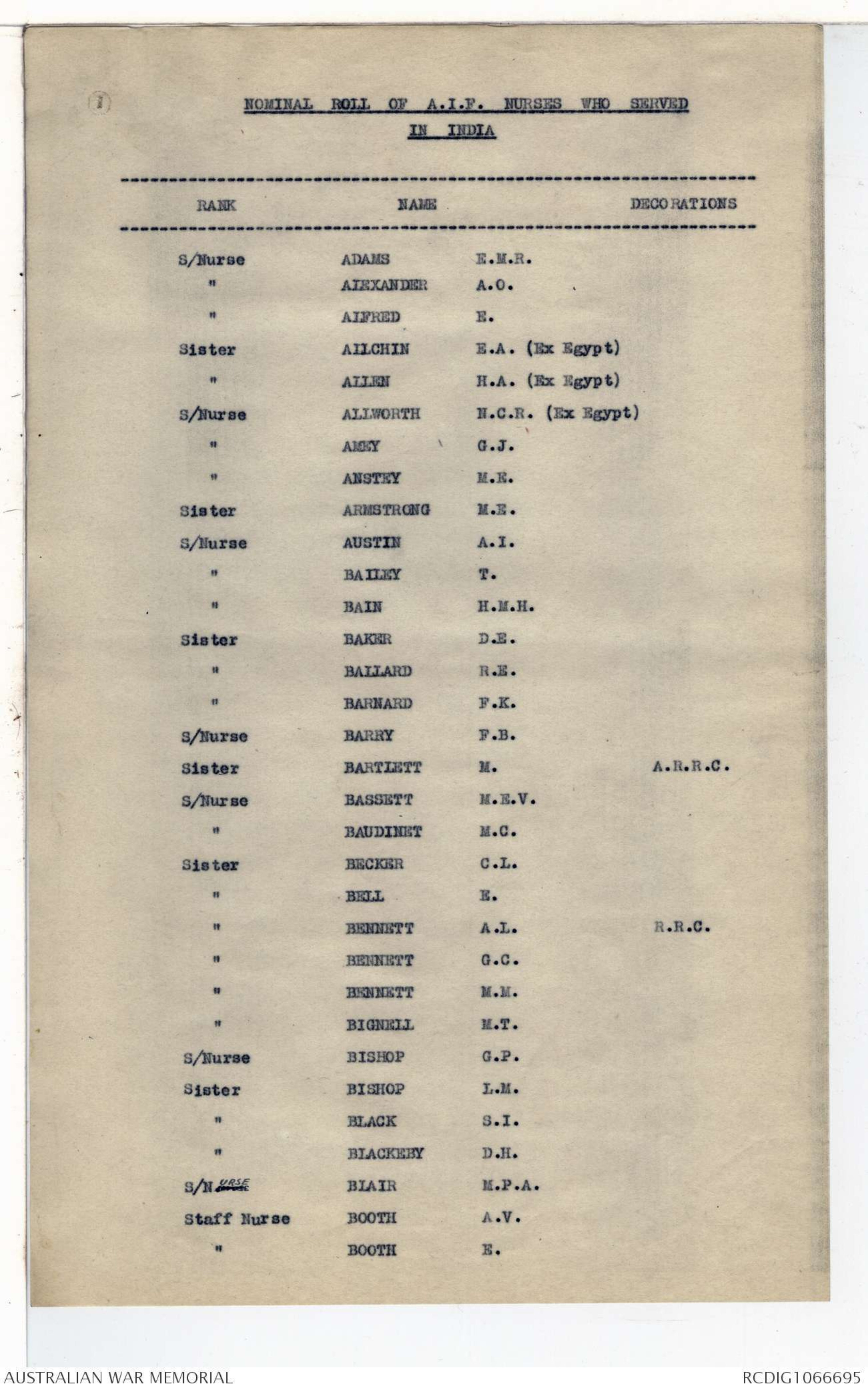
16.
only three nurses on the staff, and one of them (Sister C.
Burke) described the life as "more like being at home than
anything I experienced on service." The bungalows were fitted
with electricity in 1918, but the night sister still kept
beside her a hurricane lamp as a precaution against snakes,
which were not infrequently met in this and other hospitals.
DECCAN WAR HOSPITAL, POONA
This lay in the beautiful highland district of the Western
Ghats, 140 miles from Bombay, had only eighty beds when, only
in December in 1910, an Australian matron (Miss T.J. Dinne) and six sisters
were sent thither. A large increase, however, soon occurred,
huts being rapidly erected and the hospital being, within
three months, smoothly expanded to xxxx 1,200 beds - the
Australian xxx nurses at the same time increasing to fifty.
The patients, who flowed in from Mesopotamia, consisted at
first largely of wounded; but, as the hospitals nearer the
actual front became more numerous and better equipped, the
nature of the cases reaching Poona gradually changed, medical
cases predominating. The service in this hospital was
described by two of the Australian nurses (Sisters Derrer and
Mary Kesting) as "very varied - a wonderful experience",
including dysentery, plague, and cholera. An outbreak ofxxxxxxx cholera occurred in the Poona camps, and all
cases ware sent to this hospital. By inoculation and isolation
the outbreak was kept down to about sixty cases, but work
in the hospital was severe, the rule in cholera cases being
that the patients must continuously have the attention of a
medical officer, nurse, and orderly.
KING GEORGE'S WAR HOSPITAL, POONA
This hospital, of 600 beds, had a staff of Australian
sisters, at first under xxxxxxxx an English matron.
One of the Australian sisters. Miss Ethel Butler, who had
originally come from Australia as temporary matron, was
assistant matron until late in 1918, when she sailed to England
in charge of fifty sisters.
17.
TRIMULGHERRY HOSPITAL, SECUNDERABAD
This was in Hyderabad, the Indian state possessing the
largest native army. The Nizam maintains there also a
division of British troops as a precaution against native risings.
The native troops were largely fighting in East Africa, where
they contracted a very serious form of malaria; on their
return to their native districts they spread this xxxxx
malaria everywhere, the British troops in that state suffering
heavily. From 1916 Miss S. Hoadley of the A.I.F., with a staff
of Australian nurses, was matron of this hospital, which then
contained 500 beds. In 1918 she was succeeded by Miss Gertrude
Moberley, and the hospital was shortly afterwards increased to
1,200 beds. Its buildings had previously been a barracks of
the 7th Hussars, and were seven miles from Secunderabad and four
from Trimulgherry. From the sisters' quarters to the wards was
a mile, and they were carried to and from work in slow-moving
carts drawn by the little native bullocks. The hospital was
closed on the 7th of September, 1918.
STATION HOSPITALS
Bangalore. A large station hospital nearly two days and
nights by train from Bombay. It followed that Mesopotamian
patients were only transferred thither from the Bombay hospitals
when almost ready for convalescent depots. The place was
also a large military station. Early in 1918, when it was
taken over by Australian nurses from Indian regular sisters of
the Q.A.I.M.N.S., it was a station hospital of 150 beds.
During that year, however, the hospital was greatly increased,
Miss Dowsley being the matron. Influenza was very severe, and
at one time no less than 58 per cent of the staff was off duty,
some of its members being dangerously ill. This left nineteen
nurses to carry on all duties, day and night. Nearly all the
medical officers ware down, and each of the wards, averaging
eighty patients, was in charge of one ^sister for, in fortunate oases,
two) xxxxxxx two nursing orderlies. The matron had
18.
to exercise much care in seeing that the seriously-ill patient
were evenly distributed through the wards so as to avoid
severely overworking some of the staff. Throughout, the staff
was hampered by shortage of equipment - a condition prevailing
all over southern India.
Belgaum - a plateau station in Mysore with a good climate
and pleasant conditions. The full staff comprised four
Australian sisters, whose lot was made xxx easier bythe kindness of
the residents and the existence of a very nice united service
club.
"THE CLEANEST IN THIRTY YEARS"
Maymyo - a station hospital in Burma. The matron-in-chief
for India (of the Q.A.I.M.N.S.) paid Sister Agnes Fergus
, the Australian in charge, the compliment of saying that she
did not think it was possible to keep a hospital so clean: she
had been thirty years in the service in India and xxx had never
seen any hospital so well kept as this station hospital then
was.
THE FRONTIER WARS
Rawalpindi. When fighting occurred in Waziristan, No. 18
British General Hospital opened at Rawalpindi, the second
largest military station in India, 1,400 miles from Bombay.
Five Australian nurses were sent thither. The seriously wounded,
however, were kept at Tank, and Dera Ismail Khan on the
frontier. After three months, in June 1917, No. 18 at
Rawalpindi closed down. xxx In November of that year Australian
nurses were sent again to Rawalpindi station hospital, which
was then receiving mainly malaria cases, but afterwards smallpox.
In June 1918 the heat became intense, ranging from ll6 to
124 degrees in the coolest part of the hospital, and a run of
heat-stroke cases occurred. The local troops were largely
garrison regiments - old soldiers of the Gordon Highlanders and
the Somerset Light Infantry; and the Cordons especially
suffered. Many were afterwards mentally affected, but all cases
were as soon as possible sent to Murree, where it was cooler,
19.
and, in the xx climate of the Hills, regained their normal
sanity. During the height of this trouble some of the native
ward-boys went sick from sheer fright.
Murree. This station hospital, in the hills twenty miles
from Rawalpindi, was for a time staffed with Australian nurses.
The place was badly equipped, but, as one nurse (Sister Lardi)
afterwards wrote, "one relief was the way in which the R.A.M.C.
orderlies worked."
THE LAST PLACE GOD MADE
Tank, on the Baluchistan frontier. "Here (wrote Matron xxx
Davies), where no woman had ever been sent before - the last
place God ever made - six of the A.A.N.S. worked in the most
appalling heat one could imagine." The hospital was built of
mud, with low walls and openings for windows, and only the
crudest kind of equipment. The country was so rough that the
wounded were brought in some form of litters on camels, and were
in an upright position. They came thus nearly 100 miles, having
been given hard rations for twenty-four hours - bully beef
and biscuits, with their waterbottles filled; and they came in
always in a state of exhaustion. The sisters at Tank had a
picket of twelve Gurkhas always round their bungalow; and the
general commanding called personally to extol the praises of our
nurses, and stressed that it had made a great difference to the
sick and wounded to have them there - if the womenfolk could
stick it out, so could they. Sister E.G. Browne was in charge
here, with Sister Vera Steel, and Staff-nurses McAllister, Elsie
Jack, Dora Furness, and Emily Rogers.
Dora Ghazi Khan. The conditions here were similar to those
at Tank, but not quite so severe. Australia sent thither three
sisters - E. Horne, Beryl Tucker, and Hodgson. "The thermometer
wrote Sister Horne, who went there in March 1918, "rose to 118
and 120 degrees in the shade, but we enjoyed the work."
A COMPENSATION IN 1919
In May 1919, when the last of the hospitals in which
Australian nurses had served had been closed down, the xx Afghan
20.
war again broke out, and many of the nurses, who were waiting to
embark, had to be transferred to Rawalpindi, Gharial, and
Khuldans. All the population except the military was forced to
leave Peshawur and Kohat, officers' wives and families being
sent away to the hills. "Although we did not get home as soon
as we expected," wrote Matron xxxx Davis afterwards, "the six months
spent at these hospitals, situated in the beautiful Himalaya
Mountains, were not arduous at all, and I think all the sisters
derived great benefit from the glorious climate after the
sweltering some of us had endured for three years in Bombay.
We were housed in comfortable bungalows planted in beautiful
mountain forests, where the pine-trees grew in abundance, many
of them with the wild rose of China climbing over them. We
were 7,000 feet above sea-level, and to waken in the early
morning and drink in the champagne-like air perfumed with the
scent of these roses will outlive the memories of our less
pleasant days elsewhere in India. Miss Lily Campbell was in
charge at Khuldana and I at Gharial. It was a mile from my
bungalow to the officers' hospital (100 beds), and in that mile
we climbed another 1,000 feet. Fortunately the sisters for the
officers' hospital were accommodated in bungalows at the end of
the hospital compound." Once again, when General Burchell
came from the Western Front as D.M.S., the Australian-staffed
hospitals were commended: on his inspection in 1919 they were
the only ones picked out for special credit.
IN SOUTHERN PERSIA
At Bushire on the Persian Gulf was the only hospital near
the Mesopotamian front staffed by Australian nurses. Here
Sister Lily Stewart was in charge, with Sisters Wellard, Waterstrom,
Purcell, and Parnell. The hospital had about thirty beds
for officers and 100 for other ranks. From Bushire a railway
ran about 100 miles into Persia, and most of the troops were
doing outpost duty along this line.
HOSPITAL SHIPS - 130 IN THE SHADE:
A number of these, working from India to the Persian
21.
Gulf (Basra), Suez, East Africa, and even Hong Kong and
Vladivostok, were at various times staffed by Australian sisters.
The service was often prolonged in several ships. Sister xxxx
Horne, for example, in xxx September 1917 left
Bombay in the Vita with four nurses and twenty-five orderlies
for Basra. After a return voyage (very busy with heat-stroke
cases) in this beautifully fitted ship, she sailed in October in
the Sicilia, bringing back 400 sick or wounded men from
Mesopotamia. In December she sailed in the Delta for Suez with a staff
of five Australian nurses, three Indian trained nurses, and
sixty orderlies; on the return voyage an Indian labour corps
from France was carried - good patients, but the dirtiest with
whom she ever had to deal. She next sailed in the Delta to
German East Africa, bringing back as patients German prisoners
of war and sick or wounded Indian troops. The work in the
Persian Gulf was carried on under conditions of intense heat.
Sister Scanlan, a Western Australian who volunteered at the
beginning of the war and served in the Q.A.I.M.N.S., records
that she had many trips to the Gulf with a shade temperature of
124 to 130 degrees on board. On one trip the hospital ship
Donsola ran out of ice, and had to zigzag to provide patients
and crew with fresh air. These conditions were terribly
severe on patients with heat-stroke. One (Sister Scanlan
records) had a temperature of 113 degrees for three days: This
case ended fatally.
Sister Larkian records that, on a voyage from Basra withxxx 500 heat-stroke cases in the hospital ship Takada in 1917.
the heat in the shade on deck was 120 degrees, and so trying
were the conditions in the engine-room that the engineers went
down with heat-stroke and it took seven days instead of five to
get clear of the gulf. In the midst of it a signal was
received from another ship, and the Takada had to stop and take
on board one of the ship's engineers very seriously ill with
heat-stroke. "The matron was a Briton," wrote Sister Larkain.
22.
"She took the worst cases on deck, worked till midnight, slep
in her clothes, and was up again at 3 a.m. helping the night
sister to sponge." The temperatures of these patients ran to
110 degrees, as high as the thermometer would register. The
native Indians often refused to get well; the British "Tommies
fought splendidly for life, but many of them were afterwards
mentally effected. To give a notion of the varied nature of
the work, the records of the two following voyages may be cite
H.S. HEREFORDSHIRE
In May 1917 Sister Alma Bennett was sent to take charge of
the hospital ship Herefordshire working between Mesopotamia and
Bombay. The ship had 560 beds and a nursing staff of six - one
sister and two staff-nurses of the Australian service and three
Indian "temporary" nurses. It was in the monsoon and the
voyage was stormy, but the nurses on the voyage up the gulf
prepared their stock of dressings and got ready for the
patients as well as they could. On May l5th they reached
the entrance to the Tigris (Shatt-el-Arab), and, as the ship
could not cross the bar, xxxxx waited for the smaller hospital
ship Erinours, which was bringing the patients down the river.
Two days later, at 8 a.m., she came alongside with 260 Indian
and 240 British patients, who were quietly transferred, and at
3 p.m. the ship sailed. The heat was intense and the Indian
troops seemed to suffer more then the British, calling
perpetually for nani (water). Iced lime drinks were in constant
demand, but with Indian troops the situation was always
complicated by the fact that by their religion their food must be
prepared by their own people. Each night dozens of patients
from the lower decks were carried up into tho fresh air,
especially when, through rough weather, the port-holes had to
be closed. At the end of each voyage the Indian troops were
sent ashore in clean white cotton suits and turbans.
Miss Moberley was afterwards in charge of the
Herefordshire
H.S. Madras
23.
In 1918 volunteers were called for to staff a hospital ship
for Vladivostok, and Sister Fletcher, who for two years had worked
at the Deccan War Hospital, was chosen to go in charge, with
four friends on her staff. At the last moment three of the
staff were struck down with influenza, and their places were filled
by others. They sailed on 28th September in a transport, the
Dilwarra, for Hong Kong. This ship carried 300 troops among
whom influenza soon became rife, the nurses volunteering to look
after them. The sick-accommodation was of course utterly inadequate,
and there were practically no medical stores, but from the
Queen Alexandra sewing base at Colombo the nurses managed to get
pyjamas for their patients, of whom fifty were eventually landed
at Singapore.
At Hong Kong the nurses landed to await their hospital ship,
the Madras, and, as the hotels were dear, the authorities had very
kindly arranged to board them at the hospital. Here they
volunteered to work in order to give the local sisters some leave. So
much was their work appreciated - and so well did they like the
place - that the D.M.S. at Hong Kong cabled to Australia and
England for leave to retain two; but, before it came, the Madras
had arrived and they had sailed in her.
RUSSIANS AND CZECHS
The Madras was sent first to Vancouver, and the voyage across
the Pacific proved a stormy one. On arrival at Vancouver one
sister was married, reducing the staff to four. The Madras sailed
again on 15th January, 1919, with twenty Canadian officers for
service in Siberia, and a Russian surgeon-general. She called on
the north coast of Japan in midwinter to coal, and reached
Vladivostok in bitter weather with the thermometer thirteen degrees
below zero; an ice-breaking ship went round the harbour to prevent
freezing-in.
Here the Canadians hoped to obtain the ship to send some
of their troops to Canada, but she was required by the British for
taking home 500 Czecho-Slovaks and the Middlesex Regiment. The
24.
nursing staff was increased, an American sister and two American
nurses took charge of the Czechs, accompanying them on their
voyage and actually toPrague, and the Australian sisters going
on with the British troops to England.
NOMINAL ROLL OF A.I.F. NURSES WHO SERVED
IN INDIA
| RANK | NAME | DECORATIONS | |
| S/Nurse | ADAMS | E.M.R | |
| " | ALEXANDER | A.O | |
| " | ALFRED | E. | |
| Sister | AILCHIN | E.A. (Ex Egypt) | |
| " | ALLEN | H.A. (Ex Egypt) | |
| S/Nurse | ALLWORTH | N.C.R. (Ex Egypt) | |
| " | AMEY | G.J. | |
| " | ANSTEY | M.E. | |
| Sister | ARMSTRONG | M.E. | |
| S/Nurse | AUSTIN | A.I. | |
| " | BAILEY | T. | |
| " | BAIN | H.M.H | |
| Sister | BAKER | D.E. | |
| " | BALLARD | R.E. | |
| " | BARNARD | F.K | |
| S/Nurse | BARRY | F.B. | |
| Sister | BARTLETT | M. | A.R.R.C. |
| S/Nurse | BASSETT | M.E.V. | |
| " | BAUDINET | M.C. | |
| Sister | BECKER | C.L. | |
| " | BELL | E. | |
| " | BENNETT | A.L. | R.R.C. |
| " | BENNETT | G.C | |
| " | BENNETT | M.M | |
| " | BIGNELL | M.T. | |
| S/Nurse | BISHOP | G.P. | |
| Sister | BISHOP | L.M. | |
| " | BLACK | S.I. | |
| " | BLACKEBY | D.H. | |
| S/Nurse | BLAIR | M.P.A. | |
| Staff Nurse | BOOTH | A.V. | |
| " | BOOTH | E. | |
 Transcriber 30168
Transcriber 30168This transcription item is now locked to you for editing. To release the lock either Save your changes or Cancel.
This lock will be automatically released after 60 minutes of inactivity.